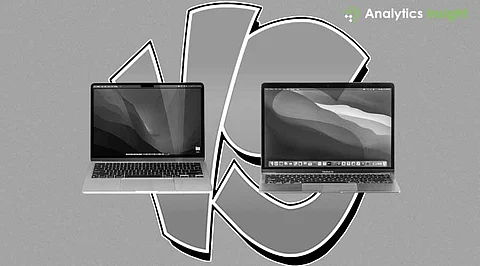

By the end of January 2025, the ultrabook market will expand to offer over 50 distinct models, each vying for consumer attention. Among these, the Apple MacBook Air M2 stands out, not just for its astonishingly compact size but for its remarkable performance as well. However, the competition from Windows-based ultrabooks is fierce, with several manufacturers offering equally compelling alternatives.
This buyer's guide explores the critical features, performance benchmarks, and user experiences of the MacBook Air M2 alongside the top Windows ultrabooks, ensuring you have all the information needed to make an informed choice.
The MacBook Air M2 boasts a robust and sleek design, crafted from solid aluminum and available in four elegant colors: Silver, Starlight, Space Gray, and Midnight. Weighing approximately 1.51 kg (3.3 pounds) and measuring 34.04 cm x 23.76 cm x 1.15 cm, this laptop is remarkably light and portable, making it an ideal companion for busy students and professionals on-the-go.
Windows ultrabooks offer a diverse range of designs, with notable examples including the Dell XPS, HP Spectre, and Lenovo ThinkPad. Most models feature sturdy aluminum construction, ensuring a premium feel and rugged durability. While weights and dimensions vary, many ultrabooks aim for a lightweight profile of 1.2-1.5 kg, prioritizing portability without compromising on performance.
The MacBook Air M2 features a stunning 13.6-inch Liquid Retina display with a resolution of up to 2560 x 1664 pixels. With a peak brightness of 500 nits, True Tone technology, and a vast color gamut showcasing over 1 billion colors, this display is ideal for both productivity and entertainment.
In contrast, Windows ultrabooks offer a diverse range of display options. Top-tier models like the Dell XPS 13 boast impressive 4K displays with high color accuracy and brightness comparable to the MacBook Air. Moreover, many ultrabooks feature touch-sensitive screens, providing an intuitive experience for users who prefer interacting directly with their display.
The MacBook Air M2 is powered by Apple's M2 chip, featuring an 8-core CPU and 10-core GPU. This configuration delivers exceptional performance for everyday tasks and demanding applications like video editing, graphic design, and more. With up to 24GB of unified memory and configurable storage options ranging from 256GB to 2TB SSD, the MacBook Air M2 provides a seamless user experience.
Windows ultrabooks, on the other hand, offer diverse performance profiles depending on the processor. Models featuring Intel Core i5/i7 or AMD Ryzen processors can outperform the MacBook Air in specific applications. Additionally, ultrabooks often come with comparable RAM configurations, up to 32GB, and offer faster SSD options, enabling quicker data access and retrieval.
The MacBook Air M2 boasts an impressive battery life, with up to 18 hours of usage under typical conditions such as web browsing, streaming, and office work. This makes it an ideal choice for users who need a reliable laptop for extended periods.
Windows Ultrabooks offer varying battery life across different models. While high-end configurations may promise 10-15 hours of usage under similar conditions, real-world performance may differ. Users should expect battery life to range from 8-12 hours, depending on the specific model, usage patterns, and settings.
The MacBook Air M2 runs on macOS Ventura, offering a seamless and intuitive experience, particularly for those already invested in the Apple ecosystem. Integration with iPhones and iPads is effortless, with features like Handoff and Universal Clipboard enabling productivity across multiple devices.
Windows Ultrabooks, powered by Windows 11, will feel familiar to Microsoft enthusiasts. Although the software landscape is vast, integrating other Microsoft devices and services isn't as streamlined as Apple's ecosystem. However, Windows 11's versatility and compatibility with various software applications remain significant advantages.
The MacBook Air M2 starts at approximately $1,099, positioning it firmly in the premium range. However, its exceptional performance and build quality justify the cost for most buyers.
Windows Ultrabooks, on the other hand, offer a broader price spectrum, ranging from around $700 for entry-level models to approximately $1,500 for high-end configurations. Pricing varies based on specifications and brand value.
The MacBook Air M2 boasts several luxury features, including:
A 1080p resolution FaceTime HD camera
Six-speaker audio for immersive sound
Thunderbolt/USB-C ports for seamless connectivity
Windows Ultrabooks offer varying feature sets depending on the model, but common amenities include:
Fingerprint readers for enhanced security and convenience
High-detail webcams optimized for video conferencing
Diverse port options, such as HDMI or USB-A ports, for expanded connectivity
Choosing between the MacBook Air M2 and various Windows ultrabooks ultimately depends on your specific needs and preferences. If you value sleek design, exceptional battery life, and seamless integration into the Apple ecosystem, the MacBook Air M2 offers high performance in a remarkably slim package.
However, if you're looking for more customization options, a broader range of software compatibility, or features like touchscreens and additional ports, a Windows ultrabook might be your best bet. Each platform has its advantages, so the key is understanding your usage patterns—whether for productivity, entertainment, or creative work—to make an informed decision that aligns with your lifestyle. Both options effectively meet the demands of today's digital world.
